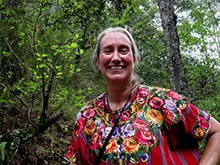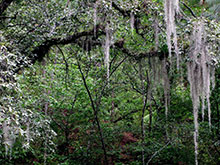
So some of you may recall that two years ago, I fell off a mountain, free fall for 10 m, with a hard stop at the bottom. I knocked myself out hitting a rock with my head. I have since conquered that mountain, reached the Mayan altar which was goal at the end of the trek, and got it all nicely documented. I had a moment of déjà vu or déjà senti on a “trail” today, but I get ahead of myself, a problem I was having on the trail too.
So this morning we got up and out early to get to a new-to-me altar called Pa Xilon. This altar is located in a lovely wooded glen/valley/ravine (depending on how deep and how steep you go). The land has been bought by a Mayan activist, so the access is free and the site well-tended. The surrounding area is clean and there were fresh offerings of flowers and fruit (apples and pineapples). The area in front of the fire circle was strewn with fresh pine needles. As we were preparing our offering, a hummingbird buzzed us, circled the altar and then zoomed off to suckle at the red flame shrubs that lined the ravine. We made our offering. Ajpub’ elaborated the parts of the day count that deal with travel and pilgrimage. We circled our feet, one at a time (doh!) thirteen times through the flames; then we took off our shoes and circled them in the blessing heat. I suspect he was prophylaxing for our trip to tomorrow’s altar, which he tells me is at the foot of a STEEP slope, but we needed all the help we could get for this afternoon.
This altar and the river at the base of the hill are mentioned in the 16th century manuscript, the Xajil Chronicle. I had looked for this site two years ago in an attempt to map the pre-contact boundaries of the Kaqchikel polity. I was delighted to find the place. We slipped and slid down the gradient to a nice tree overlooking the stream and documented it too. Then back up, helped selflessly by the stalks and stems of the hardy perennials clinging to the hillside.

Then we were off to another ceremony. This one was celebrated in the fourth plaza of the ruins of Iximche’, the pre-contact Kaqchikel capital. It was sponsored by Graham Hall (Kab’lajuj Iq’), a recent Linguistics Program MA grad, who has been volunteering this past year for a medical cooperative here, Wuqu’ Kawoq. Graham was giving thanks for the year’s experience and for the arrival of his sweetheart, a Tulane anthropology student. Special blessings were heaped on them as a couple at several times in the ceremony. After the ritual, we said good-bye to Graham and his crew of friends, who were taking off for a few days of R and R at Lake Atitlán. We also gave our thanks to the daykeeper who had officiated and then we set off to try to find one of two cave sites that are subsidiary altars to those at the archaeological site.

I had been to the first cave twice years ago and found the path right off. After that… Well, Ajpub’ took the lead and we started down the slope. The incline was severe; I would say 70%, but that could just be fear speaking. The “trail” was littered with pine needles and equally slippery oak leaves. Occasionally we could line ourselves up with big trees and let ourselves, slide, slip, fall down to the solid backstop. At other times, there was nothing to stop an uncontrolled slide. Again, I clutched at shrubs, bushes and grasses. At times the only plants available for handholds were stinging nettles. At first, I tried scrunching along sitting down, but the surfboard effect of the leaves was too scary, so I just apologized to the nettles and grabbed hold. They were remarkably forgiving and did keep me on the “trail”. Then we got to the déjà vu part of the “trail” (not that I remember the trail from 2 years ago, as the bump on the head wiped my memory for a half hour before the fall and an hour afterwards). The path diminished to a four inch trace, covered with rotting foliage. Ajpub’ was ahead of me testing each part of the trail with a staff and scooting debris to the side searching for dirt surface. He tapped his staff in front of my feet and said, “Don’t step here. There is no land, just dead leaves over air. Reach across to here.” To my left, the ravine dropped straight down to a bottom obscured by brush, an indeterminate, but long fall. To my right the hill sloped away. No robust plants, no grasses, no shrubs, no brush, no trees. I froze; only the thought that I would have a hard time clambering back up kept me moving forward. I made it across the invitation to the abyss and scrambled to an area where there was a sapling growing between me and the drop off and then took several deep breaths and the Mayan cure for fright, a drink of water. A little further on, the deadfall seemed to have been cleared out. We could see, feel, and step on earth. We had arrived at the edge of the stream at the bottom of the ravine. I realized we were lost, as I had never been this close to the water. But we found an actual path that led back up toward the plateau and the altars of the fourth plaza. I felt we were on a thoroughfare. The trail was almost a foot wide at its narrowest points and sometimes spread out to a full 18 inches. I could just walk up it, no clambering, scrambling, clawing or slithering. Wonderful!

I called Mokchewan, a friend who lives in nearby Tecpán, to see if he could visualize where we were and steer us to the cave. He recognized my description of our location, but he couldn’t really tell us how to reach the cave, though we tried at several points to follow his directions. So no cave today. We’ll try again in July, when he can accompany us.
There is a second cave in the area, but even Mokchewan has not found it, though he has searched for it, following directions from his father. Caves are portals to the spirit world, propitious for communicating with the ancestors. They provide spiritual transportation to other towns; sometimes they also physically transport transgressors who enter their desmesnes without asking permission. Caves in the Mayan area are sacred spaces. But there were no caves for us today.
I was very happy to reach the rim of the ravine again and walk out through the temples, palaces and plazas of Iximché. The rains even held off until I was safely home and showered.
A good day.

